American Goldfinch (Carduelis tristis) photos by Larry Jordan
I came across a mixed flock of American and Lesser Goldfinches a couple of weeks ago foraging in the pastures along the roadside. They were feeding on the Yellow Star Thistle and other weeds that dot the pastures in the fall. Click on photos for full sized images.
It looks like the two birds in non-breeding plumage at the bottom of the photo above are a female, on the left, and a male, on the right. Both sexes look similar to the female in breeding plumage this time of year, except their bills are dark rather than the bright orange during breeding months.
The American Goldfinch is almost exclusively a seed eater, even when feeding nestlings, suggesting that they are well adapted to obtaining all their protein requirements from a seed diet1.
As you can see, they are very adept at foraging for seeds of many varieties.
The difference in breeding and non-breeding plumage of the American Goldfinch (Carduelis tristis) is striking. The bright yellow plumage and orange beak coloration are derived from carotenoid pigments acquired from their diet1.
This is the male American Goldfinch on my Nyjer seed feeder in April.
As with other finches, the female American Goldfinch prefers to mate with the most brightly colored males, helping to ensure that they have the best foraging partners. A month later in May, you can see the bright orange bills have been attained by both the male and female.
If you want to see more great bird photos from around the world, go check out Springman’s World Bird Wednesday! And while you’re here, if you use Google Friend Connect, please consider joining my website via the widget in the right hand column of my blog and I will join yours in return. Thanks for the visit!
References: 1Birds of North America Online

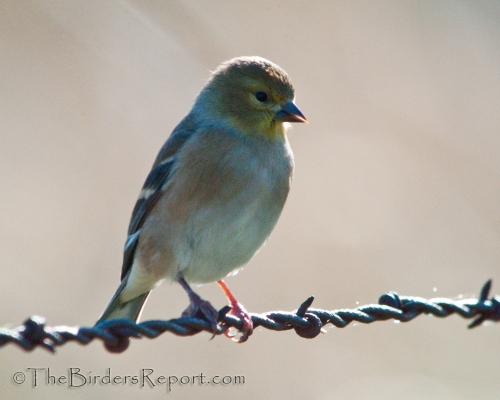
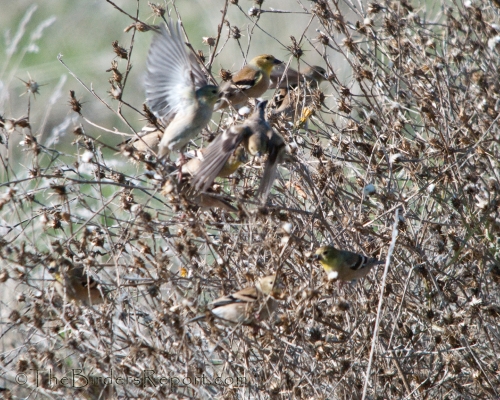
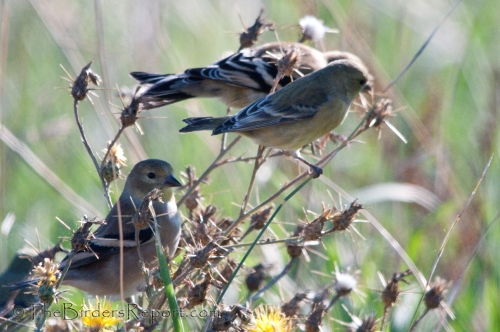
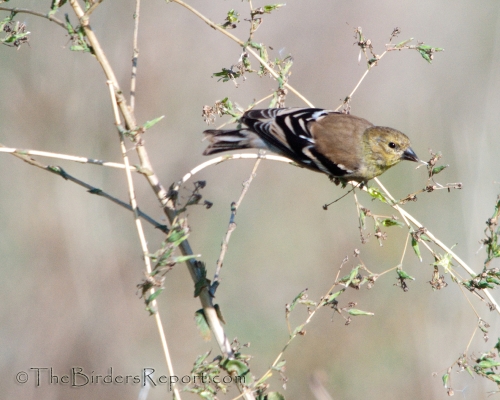
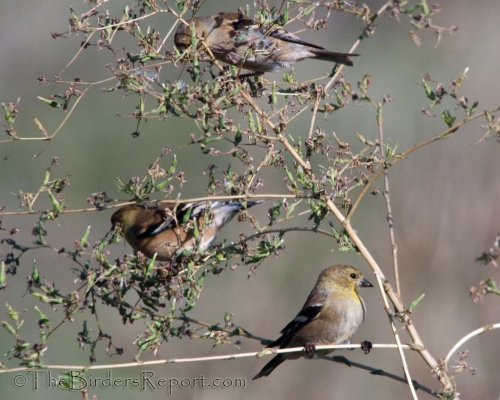
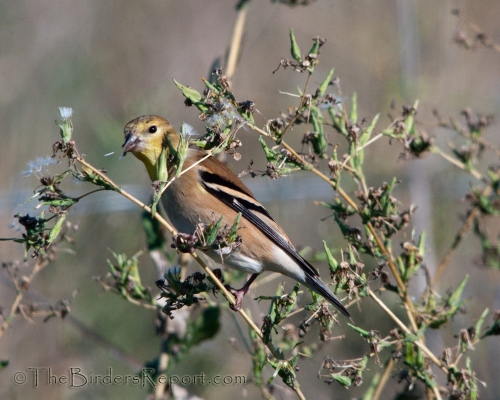
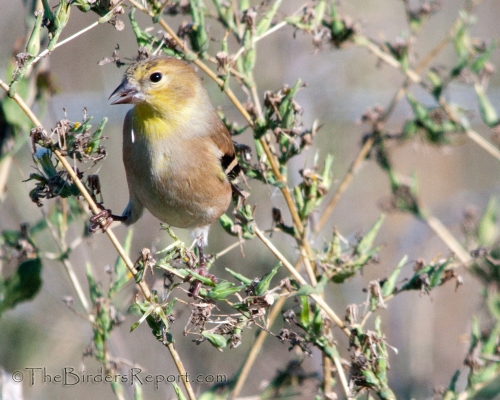
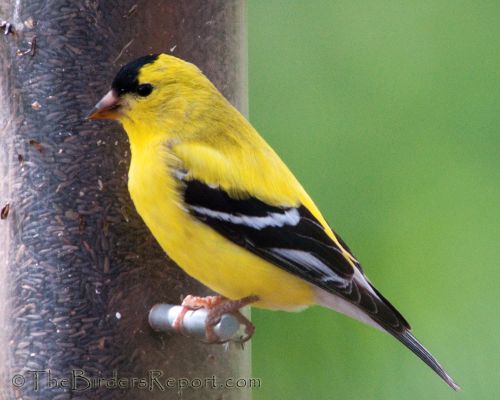
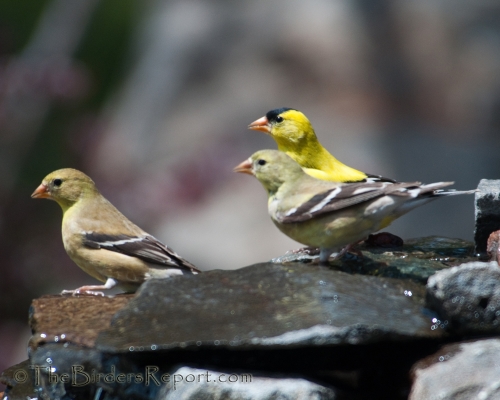








Comments on this entry are closed.
Great post on the Goldies, Larry! They are sweet birds and I love seeing them at my feeders. Always nice to see them at a natural feeding setting.
Very nice post. Love to see the Goldfinches come around, especially in their breeding colours. And I agree, it’s great to see them feeding in a natural setting.
What a great series of images, Larry!! I love the black and white markings & their wings and that bright yellow is so beautiful!
we’re finally getting flocks migrating through here in Texas. love their soft twittering. 🙂
Love the finches! Great shots!
Nice images, Larry. One of my favorite birds. Although they stay here in VT during the winter i haven’t seen any for a while.
Beautiful birds Larry.
Quite different to our Goldfinches, but just as handsome.
Again you give us not only beautiful pictures but a lesson in seasonal identification as well.
Isn’t it thrilling when you are given the gift og observing a whole flock foraging?
Good series!! Boom & Gary of the Vermilon River, Canada.
Great captures of these birds. They love thistle seeds.
A great yard bird Larry. It’s fun to watch Goldfinches gain there summer color in the spring. Hey, after your post last week about Canadian geese and Cackling geese I’m starting to see Cackling geese everywhere. Thanks for the education!
Cheers to you Sir!
that American Goldfinch is built like a canary isn’t it. I see that in other birds too; akin to a canary or a sparrow in stature. Wow what wonderful distinctive markings on the wings, and the yellow so vibrant. The first photos too were equally beautiful; thanks for sharing.
The goldfinch is one of my fav birds.They remain here all year around.I leave my seed weeds in the ground all winter for them to munch on.Great shots of them!phyllis
@Eileen I get many Lesser Goldfinches at my thistle feeders but only occasional American Goldfinches. I think I am close to their breeding range and see them as they are migrating back and forth
@Scott it was really cool to see this large mixed flock feeding in the wild as opposed to at my feeders
@Liz thank you very much!
@Theresa lucky you! I do love their call as well
@Brian thanks!
@Hilke they are hit and miss here too
@Keith I hope to see your Goldfinches some day. Puzzling about the decline in House Sparrows over there
@Arija it was so cool to see a large flock foraging out in the open like that
@Gary thanks
@Pat they do love their thistle alright!
@Dave glad to hear that you’re seeing Cacklers back there too!
@Carol the Canary is also a type of finch. From wikipedia “The Domestic Canary, often simply known as the canary, (Serinus canaria domestica) is a domesticated form of the wild Canary, a small songbird in the finch family originating from the Macaronesian Islands (Azores, Madeira and Canary Islands).
@Phyllis you are lucky to have them year round
Beautiful series!
Have a great weekend.
a great post Larry. Informative and with great shots. 🙂
Larry, I asked a birding friend of mine this question and she wasn’t quite sure. When I used to hike in the East Bay hills, I’d see flocks of Goldfinches engaged exactly as you depict here. It was pure joy to sit and watch them. In the surrounding urban areas, however, thistle was in thin supply. Do Goldfinches rely on the thistle feeders people set out, or do they manage to forage adequately without that assistance?
@Ingrid from everything I have read on feeding wild birds, they do just fine without our supplemental feedings. It helps them during migration and cold winter months but really, feeding wild birds is simply a way for we humans to be able to enjoy them at close range. Of course it helps us learn more about birds and allows us to help them in other ways. Here is Cornell Lab’s info on feeding wild birds.
Thanks very much, Larry. Speaking of feeding in the winter months, after moving to Seattle last winter, I found myself up in the pre-dawn hours, making sure I had warm nectar ready for the Anna’s Hummingbirds who stayed through the winter in my friend’s garden. Until I moved here, I didn’t have the experience of frozen and snow-covered hummingbird feeders! Usually the opposite — fermenting, hot nectar. On the thistle, what struck me about this particular situation was how frequently entire fields of invasive thistle are cleared in the East Bay hills. That made me wonder how much thistle is actually available during those months, and how much the supplemental nyjer helps.